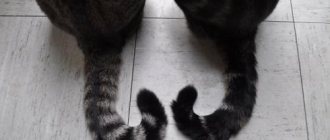Verbal communication is not unique to humans: both birds and animals have their own “language” for transmitting information messages. But with pets the situation is a little more complicated: they are forced to establish contact not only with their relatives, but also with humans. And the voice is the best option for this. This is where the popular idea that cats meow only for people originated, but in fact this theory is wrong.
Purrs
Most people are sure that this is the surest sign of feline bliss. They are echoed by cat behaviorists, who consider this statement to be fair in relation to domestic cats. Healthy and happy cats actually purr and purr for a long time! Simply place your hand on your furry pet and lightly stroke it. Did you hear the characteristic purring? Don't doubt it - he loves you very much! Sometimes cats purr to encourage their owner to do something - for example, they ask to be petted, scratched behind the ear, or played with.
It’s even more surprising that sick and dying cats sometimes purr. If you notice something like this, especially in combination with other signs - the cat has stopped caring for itself, refuses to eat, is inactive, etc. - contact your veterinarian.
Cat's meow: what is the cat trying to tell you?
Anyone who has a furry purr in their home has probably at least once wondered why the cat meows. Of course, for this animal, meowing is a way of communication. But sometimes it is so active and disturbing that the owner begins to worry.
First, I want to introduce you to the types of cat meows that you need to understand well in order to understand what your pet is trying to convey to you:
- If a cat quickly approaches you and says a short “meow,” it means that it simply greeted you.
- If you hear “Meow” several times and at the same time your furry cuddles and purrs, then he is simply happy with you. As a rule, cats tend to behave this way when their owners return home.
- If a cat says “Meow” in a normal manner, then most likely she is hungry.
- If the meow is long and protracted, then the cat wants you to let it out. For example, this often happens when a pet is trained to go “to the toilet” outside. In this case, the cat stops at the door and begins to meow.
- If “Meow” sounds in a low tone, then this is a sign of dissatisfaction. Most likely, your furry is angry that you didn't put food in his bowl or were late from work.
- If your pet says a high-pitched “Meow”, it means he is very angry with you. For example, because you stepped on his paw or tail.
Important: sometimes a cat can simply meow constantly for no reason just because she has such a sociable character. To learn to understand what your pet is trying to convey to you, just watch him for several weeks.
Meows
Cats primarily communicate with their owners through meowing. Quick and accurate translation of meowing - your cat wants something. Here and now. Attention, food, access to a locked room - look at the situation.
Meowing also indicates the cat's current mood. If she meows frequently and obsessively, it means she is very irritated. The cat meows almost non-stop, which means it needs your help. For example, she experiences severe toothache.
Well, a soft, gentle and insinuating cat “meow” is a sign of a complacent mood.
Related products
Hill's Science Plan Kitten Chicken to support immunity and healthy digestion. A diet with clinically proven antioxidants and optimal levels of DHA (docosahexaenoic acid) from fish oil. Antioxidants with clinically proven effects to support immune systems. Maintains the health of vital organs through the correct balance of sodium and phosphorus. 100% guarantee of quality, consistency and taste.
PREGNANCY AND LACTATION, KITTENS (up to 1 year), KITTENS (up to 1 year), KITTENS (up to 1 year), KITTENS (up to 1 year), KITTENS (up to 1 year), KITTENS (up to 1 year)
Hill's Science Plan Kitten with Tuna to support immunity and healthy digestion. A diet with clinically proven antioxidants and optimal levels of DHA (docosahexaenoic acid) from fish oil.
Kittens need to receive the correct amount of different nutrients for healthy growth and development. These nutrients must be precisely balanced because too much of a nutrient can be just as harmful as too little.
It is also important to use high-quality ingredients to help digestion, which is especially sensitive at this age. Hill's Science Plan diets provide precisely balanced nutrition to meet your kitten's individual needs, eliminating any nutritional deficiencies or excesses.
howls
A cat's howl cannot be confused with anything - it is a heart-rending scream, comparable only to a human scream. When two hostile cats meet, they first hiss, then start howling. A howl is a harbinger of an imminent fight.
What if the cat howls at home? This means that she is crying out for help: she is experiencing severe anxiety, pain, and discomfort. Cats also howl during the mating season, especially when they sense the proximity of a mating partner.
The cat squeals or chirps. Some experts even compare this sound to the chirping of birds, and we are forced to admit that there is something like that. Most often you can hear this sound when your pet is sitting on the windowsill and looking with interest at the birds going about their business. And he himself begins to make similar sounds! The nature of these sounds has not yet been solved by scientists and experts. It is now generally accepted that the sound was inherited by the modern domestic cat as an inheritance from the ancient ritual of hunting game birds.
Iridescent purring and squeaking
Sounds similar to the chirping of birds are acquired by kittens from early childhood.
This is a much more insistent demand than meowing. The mother cat uses them to let her kittens know that they should look at her or follow her. As an adult, the cat will squeak and purr loudly, forcing you to pay attention to something extremely important to her. Squeaks and iridescent purrs may also indicate that your cat is excited.
The kitchen hasn't been renovated since the 70s: we decided to transform it (the result is gorgeous)
The kitchen hasn't been renovated since the 70s: we decided to transform it (the result is gorgeous)
The kitchen hasn't been renovated since the 70s: we decided to transform it (the result is gorgeous)
The girl stylishly repainted the black table: photos before and after the transformation
Woman got up at 3:30 am to get her hair done at the salon after self-isolation
Hisses
This sound is often (and not unreasonably) compared to the menacing hiss of a snake. A sound that, as soon as you hear it, makes you want to retreat and move away. A cat's hiss is formed by a continuous stream of air exhaled by an animal. Hissing is almost always accompanied by body signs: the cat has an arched back, ears pinned back, etc. An unambiguous signal is sent to the enemy: if he does not disappear this very second, then in a couple of moments he will be torn to shreds. Cats commonly hiss at other cats, dogs, and even people. Cat lovers should remember: the cat hisses threateningly - it is better to move away and not irritate it.
The cat growls. Those who have a lot of contact with furry pets are well familiar with this “uterine” sound. It is somewhat similar in nature to hissing, but is more reminiscent of a growl. The sound usually indicates a cat is seriously irritated. In “real” life, you can hear this warning sound if you begin to manipulate the bowl during a meal. The cat will immediately cut you off sharply and “tell” you that this should never be done.
Do you constantly hear a growl as soon as you touch a certain part of the animal's body? Then go see your veterinarian and share your concerns with him. Perhaps the cat needs help.
FIRST METHOD: MUSIC
Cats may not have an ear for music, but they can hear perfectly well. But they perceive music differently than we do. Scientists from the Department of Psychology at the University of Wisconsin, together with musicians from the Conservatory at the University of Maryland, experimentally found out what kind of music cats like (the full text of the study is here). In short: the frequency range of sounds and the tempo of the music should correspond to the sounds and tempo of natural communication of cats.
This very “natural communication” of cats can be different. They may scream, hiss, or beg for food. Or they can rumble, purr and even snore. It follows that music similar to hissing and screaming will excite them. And similar to rumbling and purring - calming. At the same time, young cats react to music more strongly than older ones.
Low-frequency vibration, rumbling sounds, chirping birds, chirping insects and a slowly flowing melody - this is the recipe for building music for cats. When you go to work, go to the veterinarian, or go on vacation and leave your cat with a friend, play music for him so that he doesn’t worry so much.
Where can I find music for cats? You can Google it, or you can turn on Internet radio and listen to it on endless repeat. Here are the most successful examples of cat music:
— David Thea’s famous album “Music for Cats,” which we already wrote about: listen here.
— nine (!) albums of music and relaxing sounds from “Cat Music” at once: listen here.
But remember that cats' musical tastes may vary. For example, one of our cats remained indifferent to the scientific approach of David Thea, but liked the simple new age from “Cat Music”.
Prevention
Experienced breeders and veterinarians recommend that owners take the following preventive measures:
Keeping your pet in a clean and ventilated area. Regular wet cleaning, the use of air humidifiers, and the absence of tobacco smoke reduce the risk of developing a reflex cough in pets.
Prevention of hypothermia - keep in a warm room, without drafts.
Regular treatment of the animal against helminths. Excluding raw meat and fish from your pet’s diet.
Vaccination against viral infections such as rhinotracheitis, calcivirosis, etc.
Strengthening the pet's immunity: feeding with nutritious food, vitamin and mineral prophylaxis.
The owner of a furry couch potato should not ignore a cough. The cause of the reflex act can be serious diseases of the upper respiratory tract, lungs and even the heart. Under no circumstances should you self-medicate your pet. The effectiveness of treatment directly depends on correct and timely diagnosis.
Purr
Cats purr for a variety of reasons, good and bad. Although purring is a very typical sound for pets, there is something mysterious about it. Deep sound, which is usually interpreted positively, has a number of nuances.
Animals nursing newborn kittens purr to attract the attention of blind or deaf cubs, says Cat Behavior Associates, a pet website. The vibrations make the kittens cuddle with their mother.
A Brazilian travels 36 km by bike every day to take his loved one home.
The money tree pleases with lush flowering: my secret is in caring for the leaves
It’s good to wash often: myths about shampoo and hair care that only harm
As adults, cats purr to express pleasure, concern, or communicate illness, adds Cat Behavior Associates. Animals also purr to calm themselves or someone else.
Karen McComb's 2009 study, "A Cry Embedded in a Purr," is described in a 2009 issue of the British scientific journal Current Biology. It shows that a cat's purr has frequencies similar to a baby's cry, which means that animals can put certain moods and emotions into their "speech." They purr to manipulate people, mainly to get extra portions of their food bowl.
Trilling
This word is unusual for us. It is used in specialized foreign literature. It can be translated as “bringing out trills.”
This is the sound cats use to greet.
Sometimes cats make cooing, almost bird-like sounds. They differ in sound and meaning. Cat trills attract attention. It's a way of saying, "Look at me."
What are the varieties?
Devices for repelling cats are indoor, portable (hand-held) and stationary, which are installed on the facade of the house. The devices are powered via an adapter or batteries. There are models with a motion sensor that automatically detect the presence of cats in the area. The most common models are:
- Manual. These include NY-0027 with a laser beam or Ximeite, which produces sounds that are unpleasant to the animal's ear. They do not cause pain and are harmless.
- Rooms. The JF-0902 electronic device can scare a cat. It operates in a range of 9 m. It has an infrared sensor, thanks to which an ultrasonic frequency is triggered, which animals do not like. It works for no more than 10 seconds.
- Street. These include EcoSniper, Citytek Pegasus, LS-937CD. Such repellent devices are designed for a large local area and are mounted on the wall. There is also a Garden Protector device, which runs on solar panels and is installed on the ground. Scares cats, dogs, moles, and is unpleasant for mice.
Repellers at home
If scary sounds at high frequencies frighten your cat, and you are afraid to use chemicals, you can make a cat repeller with your own hands. You can use natural remedies against an unruly pet - juice or peel of citrus fruits (orange, grapefruit), rosemary, cinnamon, garlic, onion. It should be remembered that animals have a powerful sense of smell, so the odors affecting the animal’s nose should be moderate. It is recommended to dilute the juice or seasoning with water and sprinkle it where the pet is not supposed to be. A cat frightened by the smell will be weaned off. There is also an Android app that produces ultrasound that only cats can hear.











